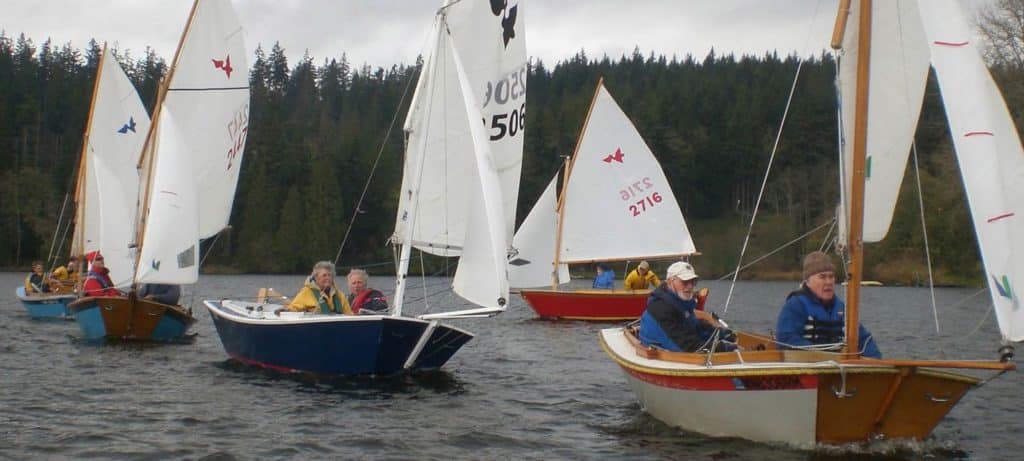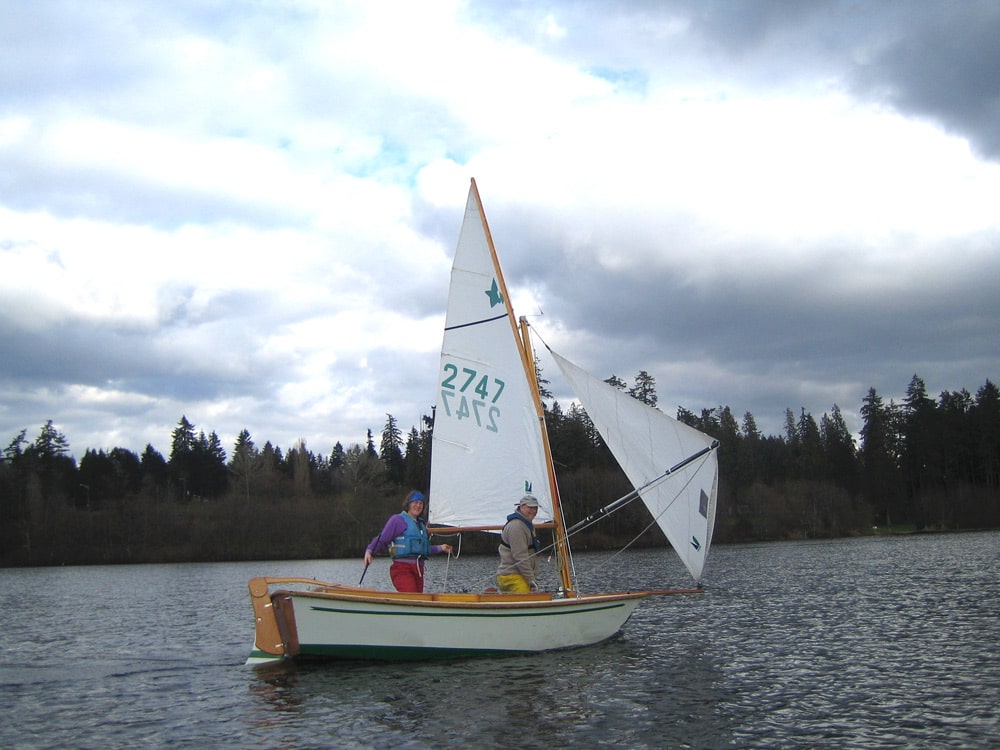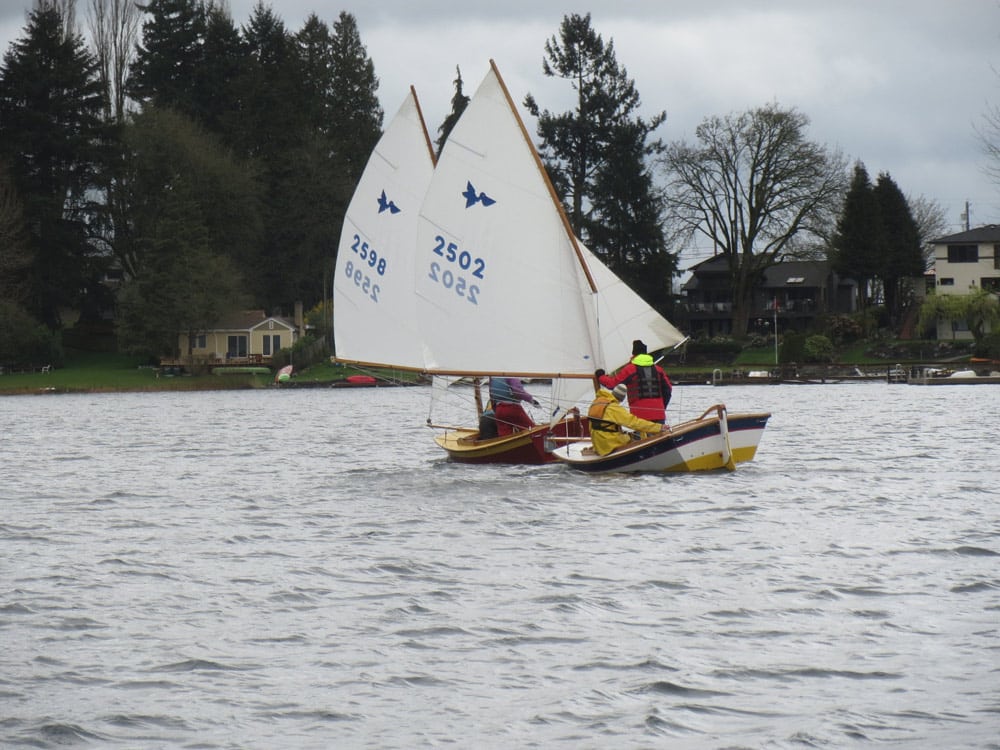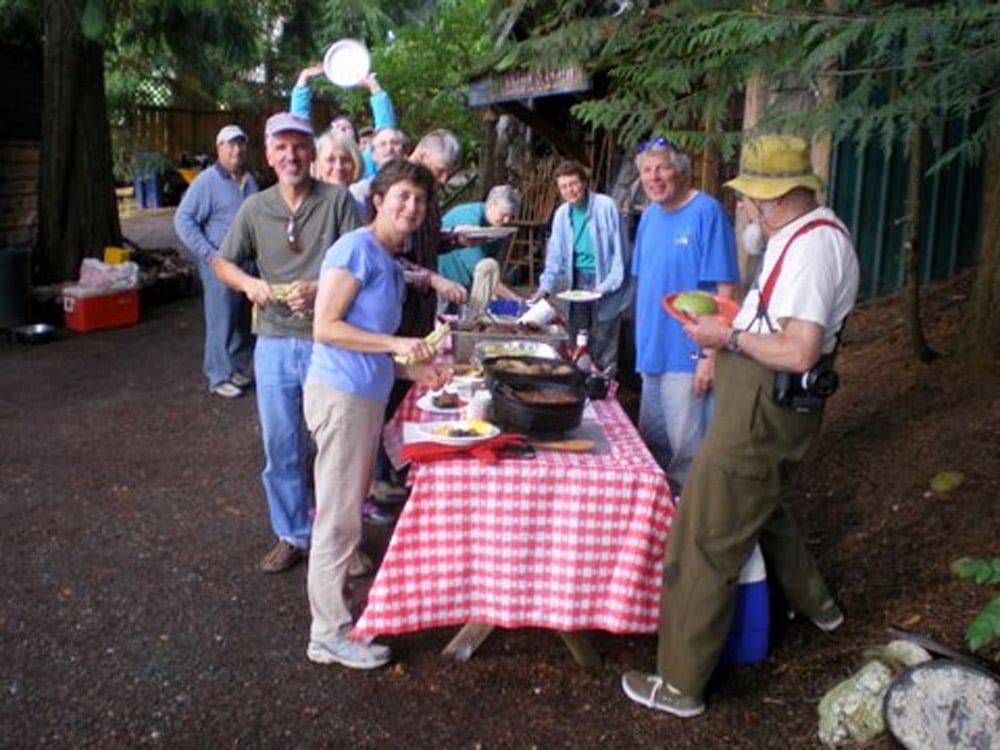
It would be hard to find a more anachronistic racing boat than a San Francisco Bay Pelican. Its short rig, 12-foot pram hull and hefty 600-pound weight don’t exactly lend themselves to heart-pounding foiling into a jibe mark. Like the bird, the Pelican looks a bit “different.” And, like the bird, it suits its environment just fine.
And for Fleet 3 in the Pacific Northwest, different is perfect. In this small fleet (around 10 active boats) the main event is usually the potluck. Wherever the potluck is, they’ll get in some races. Racing, members say, is really secondary to eating and socializing. The racing season is fall, winter and spring when there’s more predictable winds. Summers, after all, are for cruising.

The Pelican was designed by Californian Bill Short in 1959, to be easily built from sheets of plywood and sailed by a family on a budget. It was supposed to fill several roles; cruiser, racer, daysailer, fishing boat and even a yacht tender.
At the time, Fred Smith, of Samish, Washington, bought some pram plans for 25 cents and built one for his own use. It caught some neighbors’ eyes and they started lining up for one of their own, and voile, Smith and his brother Don had burgeoning careers. Then came along Bill Short’s design, Smith built hull No. 38, and it wasn’t long before Smith was building them and selling them all over. One went to Norway and 17 to a reservoir in Oklahoma.

Local families took an immediate interest. Here was a boat that was easily trailered, launched and rigged. The lug rig is an important feature. It makes it easy to step the mast, a big plus for smaller or older crews rigging at the ramp. While only 12 feet long, the Pelican is roomy and stable with high freeboard. A large rudder makes it maneuverable. But it’s not fast. As every sailor knows, if it’s one-design, it’s game on at any speed.
Don Smith was usually the race committee, and Fred was usually skippering one of the boats. It was like a builder-supported one-design class on a much small, more human scale. “It was more an eating thing than a sailing thing,” Smith admits. That said, there were and are fleet championships and everyone’s definitely keeping score. The fleet championships are done in a round-robin format trading boats between races so nobody had a big advantage.
The Pacific Northwest is blessed with countless places for Pelican racing. It could be Holmes Harbor on Whidbey Island or Gig Harbor on the Kitsap Peninsula. These are saltwater venues are protected with verdant shores and amazing wildlife that may even include whales. Freshwater venues include Lake Sammamish, Lake Union in downtown Seattle, Lake Washington, Lake Ballinger and Cranberry Lake. Over the last 50 years it would be safe to say they’ve launched and raced in scores of both freshwater and saltwater venues, and eaten salmon in dozens of backyards.
There were more distant regattas as well. Terry Gosse, who grew up racing Pelicans with her father, mother and brother, remembers well some regattas at Whiskeytown Lake in Redding, California. There’d be 20 or so local boats and about five from Seattle. According to Gosse, a disagreement over the legality of loose-footed mains put an end to Washington sailors traveling the long distance to that regatta.
Pelicans are cruise-able, not just in theory, but in reality. Families would launch, pile into the Pelican with a tent and camp stoves and sail as a group to one of the Northwest’s amazing islands. The requisite potluck would commence! And for the more ambitious, there were cruises up to 10 days or more all the way up to Nanaimo on Vancouver Island. For those drizzly Northwest days and nights, a boom tent could be rigged. Regarding food, “you just needed to bring a shovel,” according to Fred Smith. After all, the Northwest clams, geoducks and crab are great eating.
Here is where Fleet 3 comes into its own. How many classes have a state park beach named after them? Fleet member Robert Kotovic remembers that one of the members knew someone in the State Parks office and Parks decided that since the Pelicans used a certain beach on Cypress Island so often, it might as well be named Pelican Beach. And the fleet responded by building solar-powered composting toilets.

The most memorable gatherings were the Boat Shop Regattas that Fred and Don Smith put on. They’d invite all their El Toro owners (there were more than 1,000) and Pelican owners, and about 50 total would turn up for two days of racing, camping and eating at the Smith’s property. There were also years of memorable fleet championships sailed on Seattle’s little iconic Green Lake. A raft would be anchored in the middle of the lake so boats could be traded easily in the round-robin format. The constant stream of park walkers could actually see sailboat races.
Interestingly, Fleet 3 also has one of the world’s, fastest drivers on the water. Hydroplane racing is huge in the Northwest, and for many years Chip Hanauer was the fastest “pilot.” After retiring, he was looking for a bit more sedate pace and a welcoming community, and found that by slowing down by about 200 mph he found a real home in the Pelican fleet. “What’s cool about the Pelican is it fits in a one-car garage, one guy can hook the trailer, you don’t have to have moorage and you don’t have to have a one ton truck to haul it around,” he says.
Fred Smith has watched the fleet dwindle over the years. “Fifty years ago people were looking for things to do. Not so much now.” But Fleet 3 carries on with no clubhouse but lots of enthusiasm. Today, many of the races are being sailed in coordination the newly formed South Whidbey Yacht Club. Like Fleet 3, it has no clubhouse but does have people committed to camaraderie at the local level.
Gosse, who remains an active racer if not much of a cruiser, explains one of the Pelican’s main appeals, cost. “People think you have to have money to sail. Pelicans are proof you don’t. Fleet dues are $12 per year, a Washington State Park Discover Pass allows you to launch for virtually nothing and you can still race with 15-year-old sails.”
It goes without saying to join the fleet you’ll need a dish to pass for the potluck.









